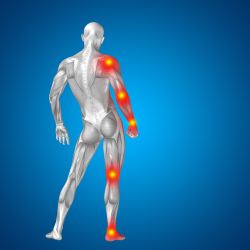
A new study, to be published in the journal Arthritis Care and Research, estimates the increasing public health burden of arthritis and other rheumatic conditions. Dr. Guang-Ming Han from the University of Nebraska Medical Center, and colleagues, used data in Nebraska between 2007 and 2012 from annual rates of state emergency department (ED) visits, hospitalizations and mortality. The conditions evaluated included gout, osteoarthritis and rheumatoid arthritis. The investigators found that over the time period studied, the annual rate of ED visits with the targeted diagnoses encoded increased by 34 percent (from 963 per 100,000 to 1,292 per 100,00). Similarly, that of hospitalizations for those diagnoses increased by 22 percent (from about 1600 to 2,000 per 100,00) over the same period from ailments related to arthritis and other rheumatic conditions, or AORC. When they examined the diseases giving rise to these increases, they found that gout and related ills were responsible for much of the increase. For gout, ED visits increased by over 90 percent, and hospitalizations for gout and related conditions also increased by 76 percent. Gout is a disease in which the metabolic breakdown product of cellular DNA, uric acid, attains high levels in the blood. Then crystals of uric acid deposit in some joints (the big toe is frequently affected, but the knee and elbow are also sites of inflammation); the body responds by setting up an inflammatory reaction, which is often exquisitely painful. Costs for dealing with AORC increased by nearly 57 percent for ED visits, and by 16 percent for hospitalizations. One strong hypothesis for the reason behind these increases is simply the increased prevalence of obesity in the United States. According to the CDC, the prevalence of obesity has been increasing nationally. Nebraska has not had the greatest prevalence of obesity compared to other states yet it too has seen an increase. And obesity, it is well known, is linked to a myriad of illnesses such as metabolic disorders (gout would likely fall here) as well as Type-2 diabetes and worsening of arthritic conditions. It would seem that getting a handle on obesity finding reliable methods of prevention and cure would go a long way towards managing a number of other illnesses and dealing with the inflation of healthcare costs.
